Weather Analysis with Fitness Calendar in Excel Template
Today, the fitness industry is a highly competitive market. In the field of fitness technology, gadget manufacturers are developing numerous software solutions for tracking various body metrics under physical stress during workouts and in recovery periods. Surprisingly, despite fierce competition in the fit-tech apps for fitness trackers, no gadget manufacturer has yet offered a solution for one important user need shared by both fitness enthusiasts and professional athletes. Specifically, a software tool for analyzing body metrics under various weather conditions during workouts.
The impact of weather on humans is a significant factor that greatly affects progress, achievements, the course of training, and health safety. People should live in harmony with nature and train in harmony with the weather. We present a conceptual solution in Excel for visual analysis of body metrics under different weather conditions throughout the year. Input data is entered on the "Data" sheet, which includes statistics collected from a fitness tracker and online weather archives. This Excel dashboard template could serve developers as a prototype or concept for fresh ideas for fitness wearables.
Analyzing the Correlation Between Weather Data and Fitness Calendar
Many have heard of weather-sensitive individuals—those who experience headaches, heart issues, or asthma flare-ups with changes in temperature, humidity, or atmospheric pressure. In reality, any body is inevitably sensitive to the weather, but not every fitness enthusiast realizes this.
Fitness trackers can display the weather forecast and current conditions on their screens. However, for effective athletic achievements, it's essential to gather weather statistics just as body metrics are collected. Visual reports for analyzing the correlation between weather and body metrics, with visualization of all collected statistical data, are particularly important. Such fitness trackers could help quickly create effective training plans under various weather conditions, enhancing athletic achievements and promoting health! Overall, this enables a better strategy for physical development.
This visual dashboard template presents the following weather statistics:
- Cloud cover, air temperature, atmospheric pressure, and the UV index:
- Daylight duration (from dawn to dusk), atmospheric humidity, wind speed, and direction:
- A summary scale with daily weather data (cloud cover and air temperature) over the course of a month:
- Data selection from the statistics is managed by an interactive calendar with day, month, and year navigation:
- Outdoor distance covered daily over the course of a month:
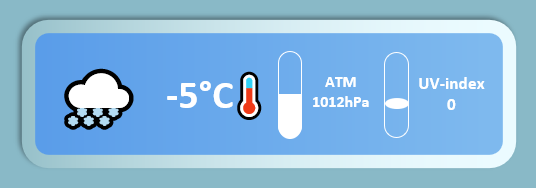
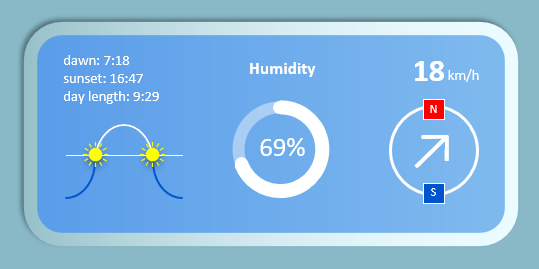

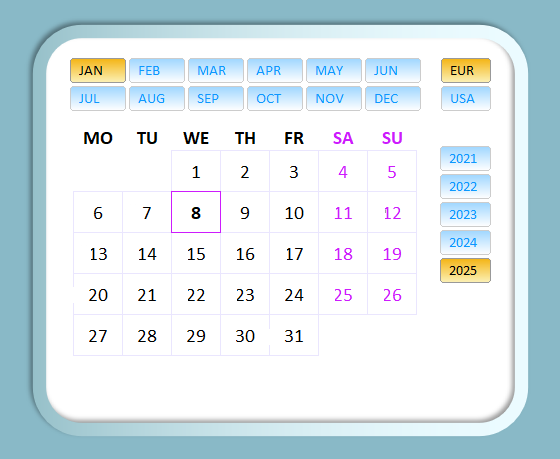

The main goal of this template for analyzing the correlation between body and weather metrics is to teach people to listen to and understand their bodies during workouts and recovery. Physical exertion and digestion are important and complex processes that should be synchronized with nature and, therefore, the weather.
The Impact of Weather on Fitness Training and Results
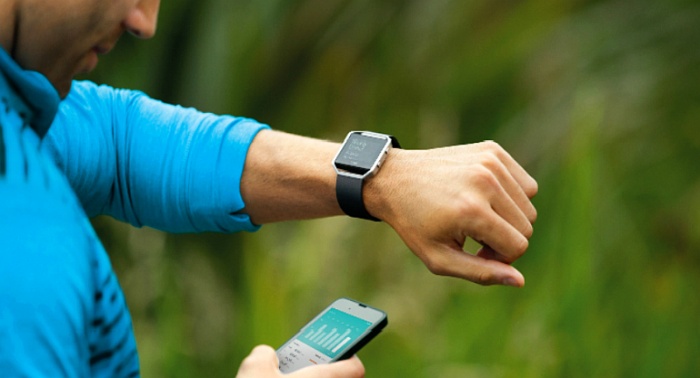
If you observe how your heart rate changes with temperature fluctuations during runs, you’ll see the connection between temperature and beats per minute under identical physical loads.
Physical discomfort is often caused by changes in atmospheric pressure, humidity fluctuations, and active phases of the Sun and Moon. Although the latter isn't directly related to weather, changes in radiation, gravitational, and magnetic forces also impact the human body—an undeniable fact.
When the body is out of harmony with the weather, oxygen supply to brain cells decreases, blood thickens, circulation slows, and discomfort and malaise occur.
Symptoms manifest as sudden mood swings, often resulting in low spirits or depression. There may be lethargy, drowsiness, loss of appetite, weakness, and a drop in energy. Blood pressure may fluctuate, nausea, headaches, and joint pain (often in areas of old injuries like sprains, dislocations, or fractures) are common.
Many fitness enthusiasts who feel weak believe that exercise will only worsen their condition. However, with proper assessment of current weather and selection of appropriate exercise types, the workout will have the opposite effect.
A drop in air temperature also significantly affects fitness training efficiency. Anyone who regularly trains outdoors knows that temperatures below comfortable levels decrease performance.
Note: a temperature drop of 4 degrees below the athlete's normal range reduces performance by 10%. A drop of eight degrees reduces performance by 20%. Do not increase the load by more than ten percent!
The Influence of Sun Activity on Health Exercises
Some people enjoy fitness training in warm weather, others prefer working out under the blazing sun, and some aren't even deterred by pouring rain. However, it's often necessary to stick to workout plans even in uncomfortable weather conditions. For better or worse, fitness is closely tied to the environment and weather. Therefore, it’s essential to consider its influencing factors. One of the main factors is the sun.
Premature skin aging, dryness, and crow's feet at the corners of the eyes are just a small part of the consequences of excessive sun exposure. Much more serious are the risks of skin cancer, sunburn, heat strokes, and more. Such workouts only worsen health conditions.
Sports science has long studied issues related to the acclimatization of athletes and the mechanisms by which their bodies adapt to various climate conditions.
In close collaboration among sports scientists, coaches, and athletes, hundreds of studies have been conducted on these topics. As a result, the following conclusions were made:
The graph of athlete performance changes depending on the air temperature in the environment:
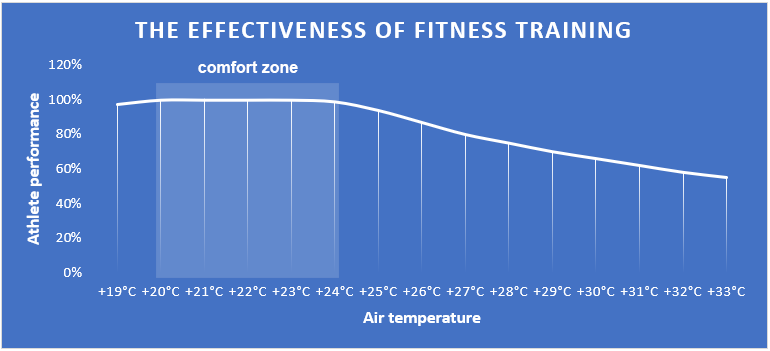
The graph clearly shows that +25 degrees Celsius and above sharply reduce performance and accordingly increase physical strain on athletes' bodies. The research also indicated that after 20-30 minutes of active workout under a steady temperature of +25 degrees Celsius, there is a significant decline in performance and loss of concentration compared to the comfortable temperature range of +20°C to +24°C.
In hot climates, athletes' performance typically decreases due to body overheating and significant fluid loss (more than 2% of body weight). Sweating helps cool the body and releases excess heat generated during muscle activity. However, along with sweat, athletes also lose essential microelements (Na, K), which are involved in the contractile function of skeletal muscles and the heart. Even with mild dehydration, athletes often experience headaches, fatigue, and difficulty concentrating, even during light strength or cardio workouts.
In hot climates with high humidity, water evaporation from the skin’s surface decreases, leading to lower loss of microelements. But such conditions complicate thermoregulation for athletes, potentially causing heat strokes or even fainting.
Optimal Solutions for Training Under the Hot Sun

Maintaining performance in hot climates requires replenishing water and electrolytes, such as Na, Cl, and K, lost through increased sweating.
During training and competitions, it’s also essential to regularly consume fluids, such as cool water or sports drinks.
Drink in small amounts but relatively frequently. Avoid carbonated water, as it can intensify thirst.
Monitor your blood pressure, and if it rises, reduce water intake accordingly.
In hot weather, it’s also important to choose the right attire and protective gear. Use sunscreen before working out. For outdoor play, a sunscreen with an SPF of 30 or higher is recommended.
With a high ultraviolet index (>3), polarized sunglasses can provide effective eye protection. Sports sunglasses prevent sand particles, shield against blinding sunlight, and help preserve eye health.
Special athletic wear made of lightweight synthetic materials that can wick moisture from the body’s surface and even cool it is suitable for safe and effective training in hot weather.
Helpful tip: special protective socks will ensure effective and safe fitness training on hot sandy beaches.
This article describes only the basic examples of how weather impacts fitness. And there are many more! While fitness app developers work on similar programs, you can already use a ready-made solution in the form of an Excel template:
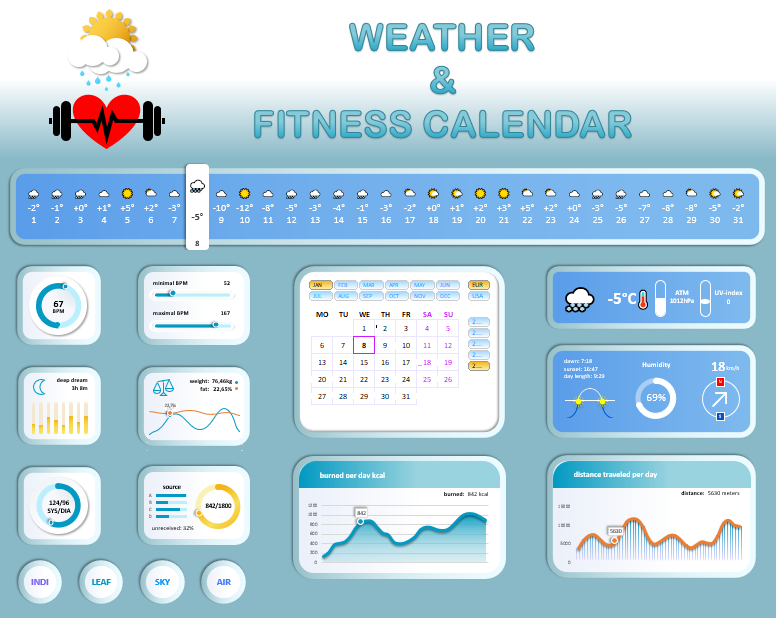
 Download weather analysis and with a fitness calendar in Excel
Download weather analysis and with a fitness calendar in Excel
A detailed description of how this visual fitness report works can be found in this article:
 Fitness calendar with weather analysis download template in Excel
Fitness calendar with weather analysis download template in ExcelFor each data visualization element, there is a description with illustrations in picture instructions.
In our lives, external factors can often disrupt our mood and affect our usual routines, but even in the most chaotic situations, it’s essential to recognize areas of harmony to protect ourselves and move forward. Effective resources already exist for this purpose. The versatile Excel analytical tool, data visualization, and automation are designed to quickly and effectively bring order out of chaos.
